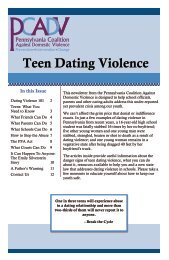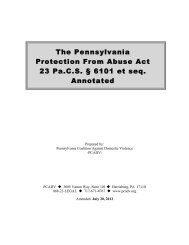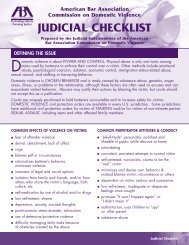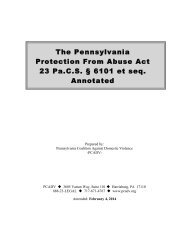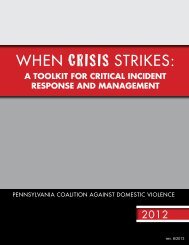December 2012 - Pennsylvania Coalition Against Domestic Violence
December 2012 - Pennsylvania Coalition Against Domestic Violence
December 2012 - Pennsylvania Coalition Against Domestic Violence
Create successful ePaper yourself
Turn your PDF publications into a flip-book with our unique Google optimized e-Paper software.
Courtroom Evidence: A Resource for The Prosecution of <strong>Domestic</strong><br />
<strong>Violence</strong> Cases<br />
Written by: PCADV Legal Department<br />
<strong>Domestic</strong> violence cases present unique discovery and evidence issues. To assist prosecutors in their<br />
efforts to hold domestic violence perpetrators accountable by prosecuting domestic violence cases, the<br />
<strong>Pennsylvania</strong> <strong>Coalition</strong> <strong>Against</strong> <strong>Domestic</strong> <strong>Violence</strong> (PCADV) has developed a new resource, Courtroom<br />
Evidence: A Resource for the Prosecution of <strong>Domestic</strong> <strong>Violence</strong> Cases.<br />
This resource is designed to provide prosecutors with the legal basis for strategies to overcome<br />
evidentiary challenges and to more effectively prosecute domestic violence perpetrators through the<br />
use of evidentiary rules and relevant statutory and case law. This resource concludes with substantive<br />
information about domestic violence, including information about the dynamics of coercive control,<br />
separation violence, and the possible use of expert testimony to explain victim behavior.<br />
In all, a deeper understanding of victim and perpetrator behavior, coupled with advanced strategies for<br />
the admission of evidence, will enable prosecutors to paint an accurate picture of the circumstances<br />
surrounding the case and, in turn, will allow the judge or jury to make a more informed decision.<br />
Courtroom Evidence focuses on some of the most pressing issues when prosecuting domestic violence<br />
cases: the confrontation clause, evidence-based prosecution and social media authentication. This<br />
article also summarizes these key topics and explains how the prosecutors’ resource will assist<br />
prosecutors faced with complicated domestic violence cases.<br />
Confrontation Clause<br />
<strong>Domestic</strong> violence often has only two witnesses: the victim and the perpetrator. But if a victim is<br />
unwilling or unable to testify, either because he or she fears retaliation by the perpetrator, was<br />
incapacitated or even killed, the prosecution must rely on out-of-court statements to police, family,<br />
friends, and others. Unfortunately, the admissibility of such statements is uncertain. Over the last few<br />
years, developments in Confrontation Clause jurisprudence have made it increasingly difficult to<br />
introduce evidence of domestic violence in cases where the victim is unable to testify.<br />
Courtroom Evidence examines the ways in which confrontation case law allows for the admission of outof-court<br />
statements made by a victim of domestic violence, and provides strategies that prosecutors can<br />
use to overcome confrontation hurdles. Analysis of confrontation case law provides in-depth<br />
information about recent legal developments and avenues.<br />
For more information about the Confrontation Clause please see:<br />
U.S. Supreme Court Decision Giles v. California, STOP Newsletter, Spring 2008 available at<br />
http://pubs.pcadv.net/palegal/STOPnewsletterSpring08.pdf.<br />
Crawford-Hammon-Davis: Trio of Supreme Court Opinions Impact Evidence-Based Prosecutions, STOP<br />
Newsletter Winter/Spring 2007, available at http://www.pcadv.org/Resources/WinterSpring_07.pdf



